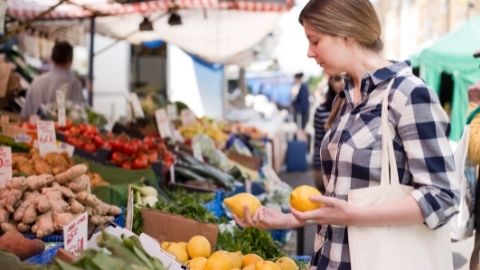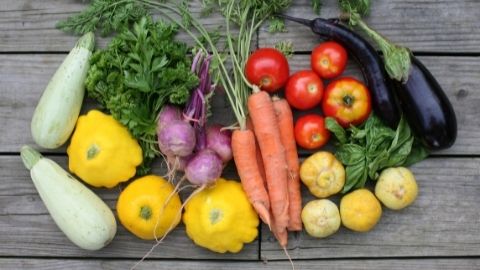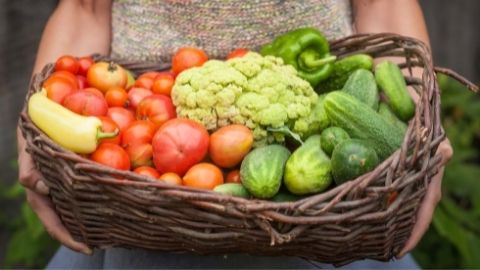Estimating Market Size and Price for Fresh Produce Sales
Introduction
When considering a new product or variety for production, a market assessment must be conducted to identify the primary consumer group for the product, often referred to as the target market. Once a target market(s) has been identified, growers should assess the available customer base and the amount of the product each customer may purchase (Tronstad, 2008). Then a feasible range of prices, that cover production costs, should be estimated. Growers should also be aware of consumer sensitivity to price changes as they expand their offerings. Completing these steps prior to growing a new product or variety, or in advance of developing a value-added product will demonstrate the potential for product success in the marketplace. A detailed business and marketing plan will also improve the opportunity or chances of securing capital funding and/or access to government grants and loans. This fact sheet discusses the process and tools available for estimated market size, as well as assessing profitable pricing, along with examples and pricing resources for fresh produce and food products. For information on target market identification and data collection see the fact sheet “Target Market Identification and Data Collection Methods” (Curtis and Allen, 2018).
Estimating Market Size
In order to demonstrate the process of assessing market size an example for a strawberry U-pick operation which caters to local customers (with families) traveling for a day or short weekend, such as in-state visitors traveling within 100 miles of their home, is provided. If the operation plans to cater to local residents, it must consider how large a radius it can draw from, in terms of how far customers will travel. The USDA Forest Service's National Survey on Recreation and the Environment found the average distance that U.S. individuals drove to visit a farm in 2000 was 80 miles (USDA Forest Service, 2003). In the West consumers travel over 75 miles to participate in U-picks, farm festivals, and related farm activities because no other closer alternatives exist for their metro area (Leones et al., 1994).
To determine the potential number of customers available within an applicable area, the population which falls into the identified target market demographics, interests, etc., must be estimated. The U.S. Census Bureau provides data related to population estimates, demographic factors, income, economic indicators, and more online at http://factfinder.census.gov/faces/nav/jsf/pages/index.xhtml. The most recent U.S. census data can be searched online by state and by zip code. The information from a census search provides an indication of the ages of people in the area, household and family size, income, ethnicity, and more, all of which can provide producers with additional information about the characteristics of potential customers in the local and surrounding area.
To estimate how much product each customer might purchase, or how much they might spend per visit, examining current and historical consumption patterns can be helpful. Average annual U.S. consumption levels of several hundred foods are readily available from the United States Department of Agriculture’s Economic Research Service (USDA-ERS) at 2 http://www.ers.usda.gov/data-products/food-availability-(per-capita)-data-system/.aspx. For some foods, consumption level information dates back to the early 1900s. Keep in mind that ERS data is for standard, conventional products only and may not be illustrative of specialty or heirloom varieties, special production methods (organic, grass-fed, etc.), or products with other unusual characteristics.
Consider the example of a producer contemplating turning a portion of an existing strawberry operation into a U-pick strawberry operation on a one-acre field, with expected production around 10,000 pounds. To calculate market size for this example, the producer must figure out what volume of strawberries would be necessary to supply all potential customers with a week’s worth of strawberries. To calculate this, multiply the acres of strawberries to be grown by the predicted growth per acre and divide this by weekly fresh consumption per capita, which is the annual fresh consumption divided by 52, the number of weeks in a year (see below).
(Average consumption per person/year)/(52 weeks/year)
Using the numbers for this example, the proposed U-pick operation would require a market size of 64,935 consumers (1-acre X 10,000 pounds per acre/(8 pounds per year/52 weeks per year)).
The producer must consider whether or not enough consumers can be found to meet the market-size requirement. It is also important to note that these numbers are for standard, conventional strawberries and the market for a differentiated product will likely be different.
The producer may be interested in targeting families as consumers. In this case, it would be helpful to know if nearby communities have enough families to make up a portion of the 65,000 customers needed to make the U-pick operation feasible. Let’s say the U-pick operation is located near Bend, OR which has 26,073 families with an average of 3.5 persons each and hence a market potential of 91,255 customers (U.S. Census, 2010). To determine what percentage of these families might visit the strawberry farm, we estimate 40% or 36,502 customers based upon the USDA Forest Service's National Survey on Recreation and the Environment, which found that 62 million Americans visited farms one or more times in 2000 (almost 30% of the population) (Barry and Hellerstein, 2004). Additionally, the agritourism industry has been growing at a rate of around 6% annually in Europe and North America" (Tchetchik, Fleischer, and Finkelshtain, 2008). If the customers purchased 16 pounds of strawberries a year, for freezing or canning for example, the operation would only need 32,467 customers, which is fewer than the estimated potential number of visitors.
Estimating Feasible Prices
There are three major pricing approaches; cost-based, demand-oriented, and competition-oriented. However, they are not normally used independently. For example, if the price demanded in the market is less than the cost of production, then a cost-based pricing approach will not be profitable. Also, while the price of competitive products can be useful, it’s optimal to design the product, service, etc., so that it is at least somewhat different from the competition, which will lead to higher market pricing.
Cost-Based Pricing encompasses both cost-plus pricing (price equals total costs divided by the number of units) and mark-up pricing (a percentage is added to the cost of the product). Major drawbacks to cost-plus pricing are that the price isn’t tied to consumer demand, there is no incentive to reduce costs, and the adjustments for rising costs are poor. Mark-up pricing is easy and can be used when there are too many products to estimate demand effectively, but since the price isn’t tied to demand, profits are biased by pricing.
Demand-Oriented Pricing sets the price at customer value (or willingness to pay). Price skimming is a practice where consumers are initially charged a high price in order to pick up consumers who are willing to pay a high amount. Gradually, the price is reduced in order to pick up consumers who are more price sensitive. Conversely, penetration pricing initially sets the price at a low level in order to capture market share, which discourages competition, and the price can be increased later when the product has become popular among consumers. Penetration pricing is very common for new food products.
Competition-Oriented Pricing is ideal when similar products exist. Penetration pricing can be used to stimulate interests in or demand for the product by setting a price that is lower than the competing product. Parity pricing simply means that the price is set equal to competing products, and premium pricing sets prices higher than the competing product. Premium pricing is often used to signal quality to consumers and maybe an optimal strategy for high quality specialty products.
When conducting a competitive analysis consider the following:
- How many competitors operate in the market?
- Are competitors large or small? Near or far?
- What types and numbers of products do they sell?
- What pricing methods do they use?
Pomegranate Juice Pricing Example
A pomegranate grower plans to produce and sell pomegranate juice retail at specialty and health stores. The grower has estimated the cost of production for each 8 oz. bottle of juice at $0.80 and wishes to add in a 20% profit to the cost of the juice, increasing the product price to $0.96 per bottle. The grower will sell the juice to a wholesaler who will charge a 25% margin which then increases the cost to $1.20 per bottle. The retailer will purchase the juice from the wholesaler and then sell it to the end customer for $1.68 a bottle, after they have added another 40% margin to the wholesale cost. Hence, the cost of the pomegranate juice has doubled from the original cost of production. Each stage of the supply chain adds their own margin to the cost and the percentages used here are the current standard for each stage.
If the grower wishes to test market his or her juice at direct markets such as farmer’s markets, stands, etc., it’s important that he/she initially price the product close to that required by the end retail level, or $1.68 a bottle. The pertinent question is if $1.68 will be profitable in the market. The average price for an 8 oz. bottle of pomegranate juice in the US in 2013 was $1.51 (USDA ERS, 2016). This price is lower than the price required but given that the intended market for this product is specialty stores where consumers may value the health or other benefits of this product, they may be willing to pay much more than the US average. Product packaging and labeling which appeals to the target market and clearly identifies the products characteristics may also improve pricing.
Strawberry U-Pick Pricing Example
Consider a strawberry U-pick operation where 10,000 pounds of strawberries are produced per acre with $23,600 in revenue per acre, assuming a retail price of $2.51 per pound (US average, USDA ERS, 2016). If the average visitor purchases eight pounds, then the producer can expect $20.08 in revenue for each person visiting the U-pick (8 X $2.51). In order to determine feasibility, the producer should now consider the costs of production for the strawberries, as well as other costs such as visitor services, permits, etc. While calculating revenues and costs is relatively simple, many factors should be considered before making a pricing decision. For example, visitors may purchase more strawberries if they are attending the U-pick as a family outing or if they are interested in canning or freezing a large number of berries. Additionally, visitors may be willing to pay more if the strawberries are a specialty item. For example, the organic price for strawberries was $5.62 per pound (San Francisco Terminal) (USDA AMS, 2018).
Assessing Consumer Sensitivity to Pricing
There are nine primary determinates of consumer price sensitivity, the first three include:
- Perceived substitution effect
- Unique value effect
- Switching cost effect
The perceived substitution effect occurs when many substitutes exist and may cause consumers to be more price sensitive. The unique value effect is achieved through differentiation. Consumers will be less price sensitive if the product or service is unique. The switching cost effect occurs when consumers are reluctant to change from one product to another due to a perception of large switching costs. Consumers can be reluctant to change and seek out new information about a product.
The next three determinants of price sensitivity include:
- Difficult comparison effect
- Price-quality effect
- Expenditure effect
The difficult comparison effect essentially means that consumers are less price sensitive when it is hard to compare products and services. The price-quality effect is an association between a higher price and higher quality. Consumers may be less price sensitive if they are quality sensitive. The expenditure effect occurs when consumers are more sensitive to price changes on large, expensive products rather than small, inexpensive ones. For example, consumers are more sensitive to changes in the price of meat compared to changes in the price of salt.
The remaining three determinates of price sensitivity include:
- Fairness effect
- Inventory effect
- End-benefit effect
Consumers may be willing to pay more for a product if they feel the value or value-added provided is higher than competing products. They are also willing to pay more for items when they area in season. For example, the demand and price of beef is higher in the summer due to outside grilling. Consumer will pay more for products that protect the environment, preserve agricultural open space, and support family farms or provide some other end-benefit.
Pricing Resources
- Fresh and processed fruits and vegetables at http://www.ers.usda.gov/data-products/fruit-and-vegetable-prices.aspx
- Organic foods at http://www.ers.usda.gov/data-products/organic-prices.aspx
- Drinks and meals away from home at http://www.ers.usda.gov/data-products/quarterly-food-away-from-home-prices.aspx
References
- Barry, J., and Hellerstain, D. (2004). Farm recreation. In H. K. Cordell (Principal Author). Outdoor recreation for 21st century America. A report to the nation: The national survey on recreation and the environment (pp.149–167). State College, PA.: Venture Publishing, Inc.
- Curtis, K., and Allen, S. (2018). Target Market Identification and Data Collection Methods. USU Extension Fact Sheet Applied Economics 2018-01pr.
- Leones, J., Dunn, D., Worden, M., and Call, R. (1994). Agricultural tourism in Cochise County, Arizona: Visitor characteristics and economic impacts. Tucson, AZ: Arizona Cooperative Extension, College of Agriculture, University of Arizona.
- Tchetchik, A., Fleischer, A., and Finkelshtain, I. (2008). Differentiation and synergies in rural tourism: Estimation and simulation of the Israeli market. American Journal of Agricultural Economics, 90(2), 553–570.
- Tronstad, R. (2008). Evaluating market size. In Niche Markets: Assessment and Strategy Development for Agriculture, WEMC FS#2-08. Online at: http://valueaddedag.org/nichemarkets.html.
- United State Department of Agriculture, Agricultural Marketing Service (USDA-AMS). (2018). Domestic specialty crops pricing report, San Francisco Terminal Market. Online at: https://www.marketnews.usda.gov/mnp/fv-home.
- United State Department of Agriculture, Economic Research Service (USDA-ERS). (2016). Fruit and vegetable pricing data. Online at: https://www.marketnews.usda.gov/mnp/fv-home.
- United State Department of Agriculture, Forest Service. (2003). National survey on recreation and the environment: 2000–2002. The Interagency National Survey Consortium, Coordinated by the USDA Forest Service; Outdoor Recreation, Wilderness and Demographics Trends Research Group, Athens, GA; and the Human Dimensions Research Laboratory, University of Tennessee, Knoxville, TN.
This material is based upon work supported by USDA/NIFA under Award Number 2015-49200-24225.
Date Published: December 2018
Authors
Kynda R. Curtis, Professor and Extension Specialist, Department of Applied Economics; Sierra Allen, Undergraduate Research Assistant, Department of Applied Economics
Related Research








